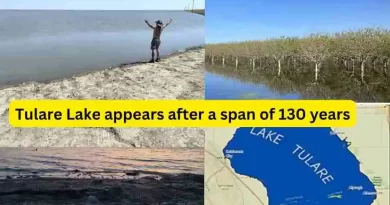NASA Detects Rapid & Massive Landslides in LA Area
NASA report shows landslide-prone coastal LA area moving rapidly toward ocean
NASA’s Uninhabited Aerial Vehicle Synthetic Aperture Radar (UAVSAR) has captured a fast-paced landslide spree of up to 4 inches a week, between Sept. 18 and Oct. 18. The Los Angeles County area which runs into the Pacific Ocean has shifted around 16 inches towards the ocean during last Autumn.
The Palos Verdes Peninsula, as per NASA’s Jet Propulsion Laboratory (JPL) report says that portions of the peninsula have expanded due to the heavy rainfall brought by Hurricane Hilary in August 2023. For more than 60 decades, the peninsular portions have been prone to landslides which is part of an ‘ancient complex.’
An additional rainfall in early 2024 also contributed to the exacerbated natural events leading to landslides. According to JPL landslide scientist Alexander Handwerger, an analysis conducted on the latest happenings shows that the movements are also increasing and affecting innumerable buildings in local communities.
Mark Pestrella, LA County public works director said, “No matter where you live in LA County, if you have slopes behind your homes, or if you’re located on top of a slope, these slopes have become fragile. The soil that is supporting your home has become fragile and damaged due to the events that we’ve had.”
As per the report from a leading US newspaper, a house in the Pacific Palisades was noticed to split into two by a landslide. The landslide, it said, mainly made up of mud and wildfire debris destroyed the property which had somehow survived the wildfires.
Handwerger said, “In effect, we’re seeing that the footprint of land experiencing significant impacts has expanded, and the speed is more than enough to put human life and infrastructure at risk.” And now, hydrologists and authorities alike have warned about a risk of landslides and debris flows in many LA areas, which have been devastated by the recent wildfires.
Pestrella again said, “There are mud and debris flow hazards that exist even when it’s not raining, so we want people to be very careful.” The reason, according to him, is that the burnt slopes might have further weakened due to the force of water from firefighting operations, resulting in inundation.
The authorities noticed large gravelly areas on the steep slopes exposed due to drying out by the fires in the Topanga and Lower Topanga areas, he said and pointed towards the reason behind triggering the downslope movement of loose particles.
Both UAVSAR and European Space Agency’s Copernicus satellite insights provided by an image and data shared by the latter, indicate the southern portion of Californian Peninsula increasingly moving towards the Pacific Ocean. Within a four-week period in August 2024, landslide-prone area which includes the residential land were moving at a rate of 10 cm (4 inches) per week towards the ocean.
The southward landslide movement towards the Pacific Ocean has been triggered by prolonged rainfall. NASA planted the instrument on a jet flown four times and a precise image was procured by using color mapping to indicate landslide speed and direction. White solid lines and the direction of the horizontal motion, representing active landslide boundaries defined by the California Geological Survey in 2007, are shown in the image.
Online data has already been sent to California officials for a proper assessment of landslides, including the people at NASA’s Disaster Mapping Portal.
Further heavy downpours in early 2024 worsened the extreme climatic conditions even further. According to NASA physical scientist Dalia Kirschbaum, speaking in a YouTube video, “the large majority of landslides around the world are triggered by intense or prolonged rainfall.” It is a fact that increasingly hotter temperatures across the world are also causing strong rain downpours.
A phenomenon known as ‘hydroclimate whiplash’ in which situations ranging from sudden movements of extremely dry to extremely wet and back again, is being seen nowadays due to an increasingly warmer atmosphere. And the warmer atmosphere creates a capacity in it to hold water, in turn, leading to extreme rainfall and also severely dry conditions, when not raining.
As of now, these conditions have been triggered and enlarged by the human-related activities causing climate change. Scientists are nowadays for more in-depth study of the hydroclimate whiplash interactions which will lead to a better understanding and thus alert the state officials and communities.
Risks related to hydroclimate whiplash and its subsequent influence on the movement of the earth are intended to be studied by Handwerger. 2022 was a surprise year for Handwerger and colleagues when they discovered a faster movement of landslides during rainy or dry seasons irrespective of soil conditions.
Apart from voicing concern about impending landslides in the wake of the Palisade and Eaton fires, US Geological Survey (USGS) research hydrologist Jason Kean, has extra tasks related to the above, at hand.
Kean who is working with the USGS’ landslide hazards program said, “Another part of our job is to estimate how big those flows will be. And a third part of our job is to estimate the rainfall rates and the rainfall thresholds that might trigger flows.”
Local emergency managers and public are alerted by the USGS in case a critical point is reached during a heavy downpour for landslide-triggering flow. This is done with the help of the National Weather Service which is passed down the assessment of the landslide by the organization.
Kean added that another inclusion in the array of tasks is the hazard assessment to, “evaluate where across the burn area we expect problems. That’s usually places that have steep slopes, like greater than 20 degrees, that are burned at high and moderate burn severity where you can see the bare soil.”








